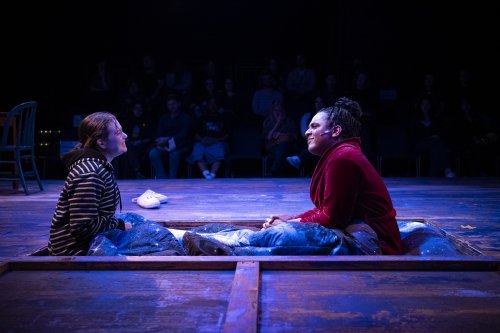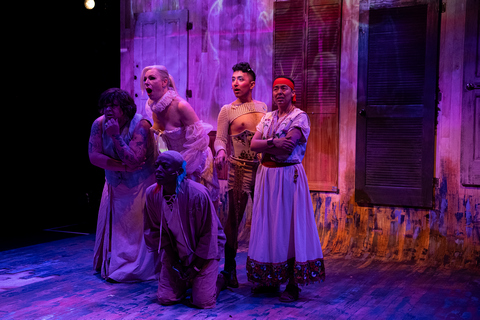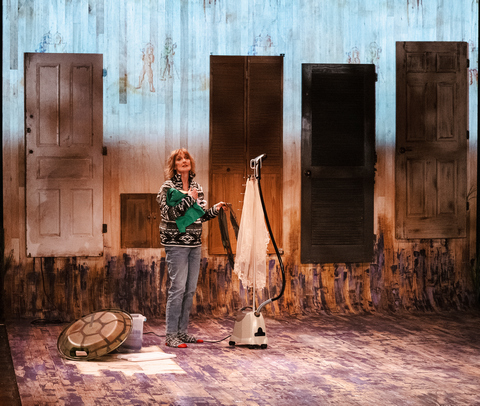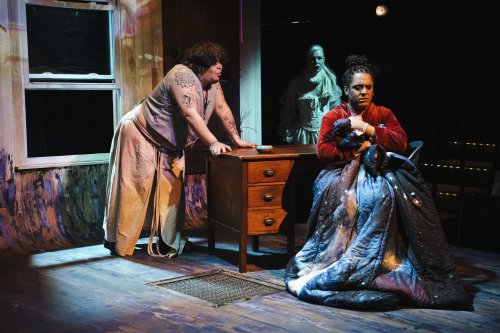House of Telescopes
Kairos Looney gives us a palette of individuals that won’t rest until their questions of how they fit into a society that doesn’t understand them are heard.

LA Head as Sherman and Joyah Dominique as Fable in a scene from Kairos Looney’s “Houses of Telescopes” at the Mezzanine Theatre at A.R.T./ New York Theatres (Photo credit: Marcus Middleton)
[avatar user=”Tony Marinelli” size=”96″ align=”left”] Tony Marinelli, Critic[/avatar]
Pipeline Theatre Company’s reputation thrives on producing “unexpected, transformative, and highly risky work.” With Kairos Looney’s touching House of Telescopes, the audience is asked to see people that are just like them, or perhaps people that they might even know. And if they can’t admit to either of those situations, they are asked to understand that sometimes you don’t really know that you know people like this.
Fable, a trans woman, has already left her family home in Colorado Springs and has settled in a large house in Minneapolis with a vibrant community of people who are similarly on a path of self-discovery outside the constraints of their own histories. The play begins with Fable calling out to her ancestors, her “roots,” here referred to as the Cartographers, in whom she is searching for answers to who she is and what history she may hold within her. Fable is very much the center of this play in that everyone else we meet exists in relation to how they impact Fable’s story and the story of those who Fable still loves.
And then we have Daphne, Fable’s mother, 983 miles away in Colorado Springs, questioning her “what ifs” as it has been a few years since son Devyn’s transitioning to Fable and she still doesn’t feel she can communicate anything that would be proactive or positive. Being honest with herself, she feels she has done what she can. Daphne’s daughter has chosen a polyamorous lifestyle and young son Jackson from her second marriage may very well be discovering he is gay. Her marriage to Gus is one based on love, but there is the built-in convenience that she gets a great deal of alone time in that his business has him travel a lot. He returns for patches of time that seem to work well with everyone’s life schedules. It’s not an ideal family setup, but Gus is a decent enough guy despite the fact he still refers to Fable as “he” and doesn’t spend enough time around his only son to pick up on the clues that he might be gay.

Rai Gonzales, Lisa Stephen Friday, Ren King, Kris Carrasco and Jen Ayala as The Cartographers in a scene from Kairos Looney’s “Houses of Telescopes” at the Mezzanine Theatre at A.R.T./ New York Theatres (Photo credit: Marcus Middleton)
The other character we are intentionally drawn to is that of Sherman, formerly CJ (what is referred to as Sherman’s “deadname,” which they change over the course of the play.) The scenes between Fable and Sherman are beautifully crafted. They may just lean on each other’s shoulder because they are kindred spirits living in Ari’s house of incredible wandering souls, and they may or may not have had a “relationship,” but they bond, and they test each other, and they run their thoughts and plans past each other.
The irony is that it took Devyn to transition to Fable and CJ to transition to Sherman and end up in Ari’s house for these true soulmates to meet. Fable resentfully sees herself as Sherman’s “Mammy” and wishes that Sherman can more often find answers to their questions on their own. The two may not see each other as soulmates, but an audience may question why Sherman and Fable don’t invest more time in each other to see if they can make it work as a true “relationship.” By the end of the play, Sherman may have found what they are looking for in Doobs, a non-binary musician in Ari’s house.
Looney has given us a bounty of fascinating characters. Even within the group of the Cartographers, described as multigenerational, gender plural predecessors, we wish we knew more about them. They provide the delicate choreography of changing scenes – an intricate dance of moving set pieces together or moving them apart to create new scenes. But then some get to stay and watch, and more importantly react, to what goes on in the play. Add to this the character known as Saved Things. Listed as from Another Realm, Saved Things is a “well-meaning demon,” a body puppet composed of Fable’s discarded childhood paraphernalia like a trophy, a graduation cap and even a Boy Scout sash. A sweet vulture of sorts, we first meet Saved Things as he hovers over a box in Daphne’s house as she sorts through things she finds to send to Fable as a delicate olive branch in their tenuous relationship with one another.

Noa Graham as Daphne in a scene from Kairos Looney’s “Houses of Telescopes” at the Mezzanine Theatre at A.R.T./ New York Theatres (Photo credit: Marcus Middleton)
Structurally, of the Minneapolis Chosen Family, the roles of Lila, the tattoo artist, Ari, the owner of the house they all live in, and Doobs, the musician who is relationship material for Sherman, could all stand to be expanded. Of the Colorado Family of Origin, the roles of Gus, Daphne’s husband, Suz and Jackson, Daphne’s daughter and younger son, and Ty, Suz’s partner, could all use some as-written enhancement enough for us to care more. An era in theater-going that pushes for 90-minute plays with no intermission sometimes leaves an audience in the lurch trying to understand how some characters fit into the grand scheme of things in the dramatic arc of the play. Such is the case with House of Telescopes. Further, the first characters to speak are the five cartographers. One wonders whether they assume the tasks of a Greek chorus, or whether they are five individual characters. The answer to that is a little of both. There are some that are more vocal than others, but none have any direct impact on an outcome in the drama.
The play is very much designed as an ensemble piece. Kris Carrasco, Lisa Stephen Friday, Rai Gonzalez, Ren King and Jen Anaya are all striking as the cartographers. Their alarm at the top of the play when Fable starts tearing apart her maps on the wall is genuine. It represents painstaking work that they have witnessed and now have watched helplessly as all of it is laid to waste. LA Head as Sherman gives a very moving performance as someone who is acutely sensitive to a lack of consideration toward transgenders. The offhandedness of the language used during an EMT class is systemic, unkind and unnerving and pushes Sherman to make major life changes that they might not have been ready to make had they not been antagonized.
Joyah Dominique as Fable is a commanding presence, one who except for one sister has not had communication with the remainder of the family in over three years. This ends up being representative of an education in communication (or lack thereof) rather than a total unwillingness to communicate. When Fable shares this information, it is out of heartbreak of not having her “family” anymore. She more than makes up for this loss with a newfound “family” which she selects in Minneapolis. The scenes between Dominique and Head are emotionally raw as they are heartfelt, two people that are new at being who they are and all the while flying without a net.

Rai Gonzalez as Brine, Lisa Stephen Friday as Ironpetal and Joyah Dominique as Fable in a scene from Kairos Looney’s “Houses of Telescopes” at the Mezzanine Theatre at A.R.T./ New York Theatres (Photo credit: Marcus Middleton)
Noa Graham as Daphne provides a performance that will resonate with audiences on many levels. How does one give birth, raise a child, and then watch as they become someone one doesn’t even recognize anymore? A parent will love that child no matter what, or so we hope. The two camps in that situation are quite disparate. Daphne has a son that has transitioned, a daughter whose sense of commitment is one that is based in relationships that are polyamorous, and another son who has something to tell his parents…they better sit down for this one. Daphne finds herself juggling a few learning curves. One thing at a time, as they say. When she shares that she has been readying her wedding veil to send to Fable it might qualify as a three-hanky moment in the play. When Fable later opens the package in her Minneapolis home, it is a happy beginning where a mother and now-daughter can rekindle what made their relationship special to begin with.
Director Lyam B. Gabel has kept a complex play about human relationships and resilience on track throughout. Scenes between Fable and Sherman are so realistic and personal in their staging, we can sometimes feel we are eavesdropping. Scenic designer Melpomene Katakalos has provided a clever set where there is the illusion the floor continues to take us upward. Doors in the wall may or may not open to a room beyond. Set pieces brought on or removed by the Cartographers is in a fluid movement that moves on organically scene after scene. Andre Segar’s lighting design is resplendent in setting intimate moments for the characters and a feast of shadows for scenes that involve the cartographers “finding things” and the character of Saved Things. The costume designs of Tẹmídayọ Amay is inventive throughout with the exciting variations of the cartographers and Saved Things to be true works of imagination here.
Playwright Kairos Looney has given us a gift in these painfully beautiful moments. We explore a family’s various ways of approaching love for and duty to each other with the result that we are all human coming as no surprise. Where sometimes there are breaks in communication, it is not about who gets “to be the better person,” but more about how we find that way to erect that bridge that brings us all together again.
House of Telescopes (through April 21, 2024)
Pipeline Theatre Company
Mezzanine Theatre at A.R.T./ New York Theatres, 502 West 53rd Street, in Manhattan
For tickets, visit www. http://www.goelevent.com/Pipeline/e/HouseofTelescopes
Running time: 100 minutes without an intermission






Leave a comment